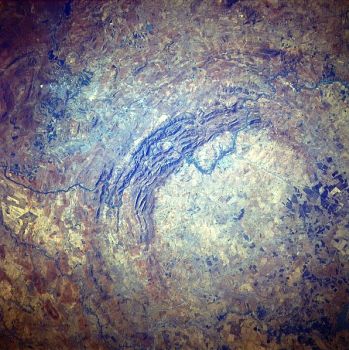Feedback archive → Feedback 2014
Craters, radiohalos, and ‘geologic time’
This week’s feedback is an example of how CMI can help creationists faced with long-age arguments, whether from atheists or their churchian allies, theistic evolutionists. While the questions below concern specifics, we explain how to answer both these specifics and the underlying assumptions behind long-age claims. First, a question about the largest impact crater on the earth, the Vredefort Crater in South Africa, is answered by Tas Walker. Second, radiohalos have long been a problem for long-age ideas, and ‘answers’ raised by critics are refuted by Jonathan Sarfati.

Janne V. from Finland writes:
Dear Sir or Madam
I would say thank you for putting all this material out! Creation.com has been a brilliant source of learning for me.
I came across a TE [theistic evolution] website and an article: [Web link removed as per feedback rules—Ed.]
Could you please address the first one: ‘Vredefort crater is very old, so if young-earth-model is true, then God is a liar.’
I tried finding information on this particular crater (or impact craters of its kind, or even if this particular one is an impact crater) from your site but could not.
Kindest regards,
Janne V.
Dr Tas Walker responds:
Hi Janne,
To my knowledge we don’t have anything on the Vredefort crater on our site. The argument you quoted was this: ‘Vredefort crater is very old, so if young-earth-model is true, then God is a liar.’
The ‘age’ of the crater is generally said to be 2 billion years, so it all comes back to the question: ‘How did they work out the age of the crater?’ All ages are based on assumptions. You need to do a bit of reading from this site to realise that the basic assumption is that Noah’s Flood never happened. See: The way it really is, Radioactive dating fatal flaw, and Radioactive dating anomalies for a few articles.
It’s unlikely that the Vredefort impact occurred during Creation week, because it was a “very good” world before sin entered it, and the effects of impact craters would not be “very good”. Instead, it is more likely that the impact occurred early during the Flood. So, when they say it is 2 billion years old, they have just put the wrong age on it.

Mike Oard has written some papers for the Journal of Creation that talk about impact cratering during the Flood, including issues such as when they occurred and how many impacts were involved. Check his paper An impact Flood submodel—dealing with issues from Journal of Creation 26(2) and What do impacts accomplish in the first hour? and Asteroid impacts from Journal of Creation 27(1).
For more information about cratering, when it occurred and discussions between creationist astronomers see: A biblically-based cratering theory and Response to Faulkner’s ‘biblically-based cratering theory’
So, back to the argument from that website: ‘Vredefort crater is very old, so if young-earth-model is true, then God is a liar.’ That argument is emotive and wrong. God did not say the Vredefort crater was old. Humans said that, but they based their ideas on wrong assumptions. The Vredefort crater is less than 4500 years old—impacted early during the Flood. God said the world is young, and so the young-earth model is consistent with God’s Word. So the truth is the opposite of what this critic claims: if the crater is millions of years old, then God has lied to us in His direct propositional revelation (facts about things) in Scripture.
All the best,
Tas Walker (CMI–Au)

Alan H. from the United States writes:
Hello, I recently watched a segment of Creation Live about an article on radiohalos and I am interested in what CMI’s response would be to this that I found on Wikipedia on radiohalos. “Critics of Gentry, including Thomas A. Baillieul (Baillieul 2005) and John Brawley (Brawley 1992), have pointed out that Po-218 is a decay product of radon, which as a gas can be given off by a grain of uranium in one part of the rock and migrate to another part of the rock to form a uraniumless halo. Apparently a large number of radon atoms are caught or adsorbed at a particular point. This has not been proved experimentally, but is supported by the fact that Gentry’s “polonium halos” are found along microscopic cracks in rocks that also contain uranium halos (Wakefield 1988).”
CMI’s Dr Jonathan Sarfati responds:
Dear Mr H.
Thank you for writing to CMI.
Really, Wikipedia is hardly a reliable source; just about anyone can edit, and a lot of the admins are fanatically anti-creationist.
The radon explanation is just nonsense, which shows the critics don’t understand basic chemistry. Radon is known as one of the noble gases, meaning that it has very weak interaction with other atoms because of a full valence shell. That means there would be no tendency for radon to accumulate at a given spot in the mineral crystal and decay to to produce the spherical radiohaloes. So no wonder there is the admission “This has not been proved experimentally.”
But we should note that the modern creationist explanation is different from Gentry’s, as per Radiohalos: Startling evidence of catastrophic geologic processes on a young earth, and this is what Creation Live was discussing. So the Wiki article doesn’t really address this claim. This really does involve transport, but of polonium. This is one of the chalcophile elements, i.e. has an affinity for sulfur, so is readily absorbed in certain centres of the minerals—unlike radon. Another article on non-primordial halos is The collapse of ‘geologic time’, further evidence for rapid geological processes consistent with the biblical timescale and global Flood.
Regards
Jonathan Sarfati (CMI–USA (formerly Au)).





Readers’ comments
Comments are automatically closed 14 days after publication.